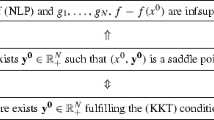Abstract
A saddle-point duality is proposed for the quasi-concave non-differentiable case of the maximization of the minimum between a finite number of functions. This class of problems contains quasi-concave (convex) programs that are known to be irreducible to convex ones. With the aid of the saddle-point duality involving conjugate-like operators, a Lagrangian is presented, the saddle-points of which give the exact global solutions. A few particular cases are discussed, among them the Von Neumann economic model and discrete rational approximation.
Similar content being viewed by others
References
I. Barrodale, “Best rational approximation and strict quasi-convexity”,SIAM Journal of Numerical Analysis 10 (1973) 8–12.
J.P. Crouzeix, “Contributions à l'étude des fonctions quasiconvèxes”, Doctoral Thesis, Université de Clermont, France (1977).
J.P. Crouzeix, “A duality framework in quasi-convex programming”, presented at the conference on Generalized Concavity in Optimization and Economics, NATO Advanced Study Institute, University of British Columbia, 4th–15th August, 1980.
J.P. Crouzeix, J.A. Ferland and S. Schaible, “Duality in generalized linear programming”, Publication 399, Département d'informatique et de recherche opérationnelle, Université de Montréal.
J. Flachs, “Global saddle-point duality for quasi-concave programs”,Mathematical Programming 20 (1981) 327–347.
J. Flachs and M.A. Pollatschek, “Duality theorems for certain programs involving minimum or maximum operators”,Mathematical Programming 16 (1979) 348–370.
E.G. Gol'Stein,Theory of convex programming, Translations of Mathematical Monographs, Vol. 36 (American Mathematical Society, Providence, RI, 1972).
H.J. Greenberg and W.P. Pierskalla, “Quasi-conjugate functions and surrogate duality”,Cahiers du Centre d'Etudes de Recherche Opérationnelle 15 (1973) 437–448.
U. Passy and A. Keslassy, “Pseudo duality and duality for explicitly quasi-convex functions”, Mimeograph Series No. 249, Faculty of Industrial and Management, Technion, Haifa, Israel (1979).
R.T. Rockafellar,Convex analysis (Princeton University Press, Princeton, NJ, 1970).
R.T. Rockafellar, “The multiplier method of Hestenes and Powell applied to convex programming”,Journal of Optimization Theory and Applications 12 (1973) 555–562.
R.T. Rockafellar, “Solving a nonlinear programming by way of a dual problem”,Symposia Mathematica 19 (1976) 135–160.
I. Singer, “The theory of the best approximation and functional analysis”,SIAM regional conference series in applied mathematics, vol. 13 (SIAM, Philadelphia, PA, 1979).
J. Stoer and C. Witzgall,Convexity and optimization in finite dimensions I (Springer, Berlin, 1970).
Author information
Authors and Affiliations
Rights and permissions
About this article
Cite this article
Flachs, J. Global saddle-point duality for quasi-concave programs, II. Mathematical Programming 24, 326–345 (1982). https://doi.org/10.1007/BF01585114
Received:
Revised:
Issue Date:
DOI: https://doi.org/10.1007/BF01585114



